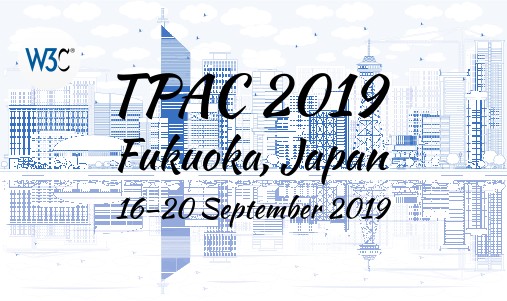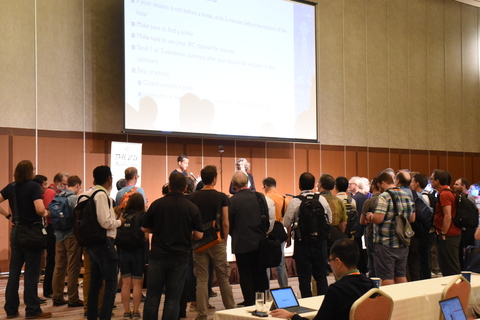Looking back at TPAC 2019; public release of W3C Strategic Highlights
We held TPAC 2019 last week in Fukuoka, Japan. TPAC is our annual five-day event where W3C's global community, working groups, community groups, the Advisory Board, and the Technical Architecture Group (TAG) coordinate the development of Web standards. Everyone meeting in one place once a year is invaluable as groups make tremendous progress and are able liaise with participants from other groups.
TPAC 2019 was fast-paced and energizing, productive, interesting and enabling. Many attended it for the first time. Many came with their fears for the Web and left with greater hope.
The records of most meetings are publicly available (please, follow the links in the detailed schedule) except for the Advisory Committee Meeting. The record of the Technical Plenary Day is public and includes photos, and the Technical Plenary Unconference agenda page already contains most of the summaries of the 59 breakout sessions that took place. Participants are invited to provide feedback on their TPAC week by 18 October 2019.

We are looking forward to TPAC 2020, 26-30 October 2020 in Vancouver, Canada, and already invite you to let us know if you plan to be a Diversity Scholarship sponsor for 2020.
The TPAC week in figures
- over 640 participated –record attendance to date;
- 33 Working/Interest groups and 13 Community Groups met over 4 days;
- the Technical Plenary day in the middle of the week was organized as a bar camp with 5 parallel tracks for 12 meetings (→ 60 sessions possible);
- 59 breakout sessions took place –breaking the previous record of 47 sessions held in Lyon at TPAC 2018 and in Sapporo at TPAC2015;
- 15 demos were presented during the Technical Plenary Day –a demonstration of the the vitality of our work groups;
- we had 19 sponsors, including network the whole week; and 10 sponsors of our Meetup on Monday –all of this as well is a record to date;
- 200 people attended the W3C Developer Meetup which featured talks by Alice Boxhall, Google; Ada Rose Cannon, Samsung Internet; Lin Clark, Mozilla; Yutaka Obuchi, Pixiv; Melanie Richards, Microsoft Edge;
- 3 volunteers translators from the extended W3C Community were invited at the Developers Meetup and celebrated for massively contributing Japanese translations of W3C specifications over the years: Shuji Kamitsuna, Yoshikazu Takamura and Naoki Nakamura;
- 4 new W3C Community Groups have already spawned from TPAC discussions (MiniApps, bullet-chatting, WoT protocol, immersive captions)
W3C Invited Expert waiver
This year, TPAC registration fees were waived for 18 Invited Experts (that is half of the Invited Experts who attended).
W3C Invited Experts bring particular expertise to W3C Groups and are invited by the Chairs (as opposed to being employees of W3C Members nominated by their W3C representatives) and approved by W3C management. Active contributors in groups that meet at TPAC and who are self-funded may attend TPAC for free.
This waiver is sponsored by W3C Members who register to the event and agree to a nominal 5% fee addition (those who do not, have the ability to opt out.)
Diversity fund
This year's Diversity fund raised nearly US $15K and allowed us to fully cover travel and accommodation for 7 attendees from under-represented groups whose registration fees were also waived.
The TPAC Diversity Fund was generously sponsored by W3C Members Siteimprove, The Paciello Group, Microsoft, Samsung Electronics, TetraLogical, Dyno Mapper, Adobe, Coil, Google, Littleguy SL; and individual sponsor Marcos Cáceres.
We believe that more diversity means better representation, which leads to better and more inclusive design. We believe that more background, more use cases, more edge cases, lead to a better Web. More diversity also brings higher quality results (you can read more in what I wrote about this last June.)
A more inclusive bar camp
This year, for maximum efficiency and inclusivity, we proposed a "no-scramble" approach to designing the unconference agenda, offered 5 slots with 12 rooms for the day (→ 60 sessions possible), and developed a mobile-friendly agenda page. That page already contains most of the summaries of the 59 breakout sessions that took place.
By popular request, we have used "Unconference" at TPAC since 2011 as the format of most of the Plenary day, where dozens of sessions take place in several tracks: an opportunity for everyone to propose, choose, and participate in breakout sessions on a wide variety of topics relating to W3C activities, and a chance to contribute to discussions and connect with people working on ideas that may not fall within their usual areas of activity.
This year, as many breakout sessions as possible were identified ahead of the actual plenary day, thus ensured a more inclusive process in how these sessions are defined and scheduled (and avoided the massive onslaught with post-it notes that disadvantages anyone new to W3C, or new to Unconference methods, and creates issues from an accessibility perspective as well as from the inclusivity standpoint)
Keynote by Jun Murai
This year, our Advisory Committee heard from Jun Murai, who is called the ‘father of the Internet in Japan’ and is a Member of the World Wide Web Consortium Steering Committee.
Murai-sensei's keynote, titled "Web on the Internet Civilization", was about how the Internet is connecting the world and is a global, single and international, space for creation, and how 5G and other telecommunication break-throughs are transforming our lives. Our one Web sits on top of the Internet and enable wonderful advances in the industries –medical, agricultrure, transportation, education, finance– that the Web vertically connects.
I would like to quote one part of his inspirational address, that to me best represents the astounding breadth and stakes for which the World Web Web Consortium strives for to make the Web work, for everyone:
"In 2000, there were 361M Internet users; Japan was 114M of those, North America 108M, Europe 105M. We knew China would come along quickly.
In 2019. Asia represents 2.2B of 4.38B users. 719M in Europe, 492M in Africa, and 328M in North America."
W3C Strategic Highlights - September 2019
Today we are releasing to the public the September 2019 edition of the W3C Strategic Highlights.
The report highlights the massive and critical work that takes place at the Web Consortium toward the growth and strength of the Web. I invite you to read it for updates in key areas, how W3C meets industry needs, and the latest around Web for all and outreach to the world.


Comments (0)
Comments for this post are closed.